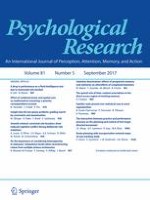27-08-2016 | Original Article
Effect of combined motor and spatial cues on mathematical reasoning: a polarity correspondence account
Gepubliceerd in: Psychological Research | Uitgave 5/2017
Log in om toegang te krijgenAbstract
We examined whether combined motor or spatial polarities could influence accuracy in two mathematical operations. Four experiments were conducted and showed that, when two corresponding polarities were activated, accuracy in multiplicative operations was greater than when non-corresponding polarities were activated, whereas no effect was found for additive operations. These results were established with motor cues (Left/Right and Arm Extension/Flexion, as behavioral approach-avoidance tendencies) and perceptual spatial cues (Left/Right and DOWN/UP cues). A polarity correspondence effect was established and proposed for multiplication. A combination of polarities was associated with a corresponding combination of numerical digits, assessed with mathematical operations, such as multiplication.
